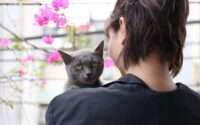Why Are Ragdoll Cats Called Ragdolls? Everything You Need to Know
Have you ever wondered why are Ragdoll cats called Ragdolls? These beautiful, blue-eyed felines have captured the hearts of cat lovers worldwide, but the origin of their unique name remains a point of curiosity. Understanding the story behind the name not only gives us insight into the breed’s history but also highlights the distinctive traits that make Ragdolls so special.
In this article, we will explore the fascinating background of Ragdoll cats, delve into their unique characteristics, and uncover the reasons behind their captivating name.
The Origins of Ragdoll Cats
The history of Ragdoll cats begins in the 1960s with a woman named Ann Baker. A Persian cat breeder in Riverside, California, Ann Baker was determined to create a new breed of cat that combined the best qualities of different feline breeds. The foundation of the Ragdoll breed can be traced back to a white domestic long-haired cat named Josephine. Josephine, who had the temperament and physique that Baker found desirable, became the progenitor of the Ragdoll breed.
Ann Baker carefully selected cats with specific traits to mate with Josephine, focusing on producing kittens that were not only beautiful but also possessed a unique temperament. The result was a new breed that exhibited docility, affectionate nature, and an inclination to go limp when picked up—a behavior that would later influence their name. Baker’s meticulous breeding program led to the development of the first true Ragdoll cats, and from there, the breed’s popularity began to grow.
Baker was fiercely protective of her new breed. She trademarked the name “Ragdoll” and set strict breeding standards to ensure that all Ragdolls maintained the traits she had worked so hard to cultivate. Her efforts paid off, as Ragdoll cats quickly gained recognition for their striking appearance and gentle demeanor, becoming beloved pets and companions around the world.
The Unique Traits of Ragdoll Cats
Ragdoll cats are renowned for their stunning physical characteristics and endearing personalities. One of the most striking features of Ragdolls is their captivating blue eyes, which stand out against their semi-long fur. Their coats come in various color patterns, including colorpoint, mitted, and bicolor, each adding to their unique charm. The soft, silky texture of their fur invites petting, which suits their affectionate nature perfectly.
But it’s not just their looks that make Ragdoll cats special. These felines are known for their calm and gentle demeanor. Ragdolls are often described as “puppy-like” because they are so friendly and sociable. They love to follow their owners around the house and are known to greet their humans at the door. Unlike many other cat breeds, Ragdolls tend to be very relaxed and are known to get along well with children and other pets.
When compared to other cat breeds, Ragdolls stand out due to their docile nature. While many cats are independent and aloof, Ragdolls thrive on human interaction and enjoy being held and cuddled. This affectionate behavior, combined with their tendency to go limp when picked up, is one of the many reasons they have earned such a special place in the hearts of cat enthusiasts.
Why Are Ragdoll Cats Called Ragdolls?
The name “Ragdoll” might seem whimsical at first, but it perfectly describes one of the breed’s most distinctive traits. When picked up, Ragdoll cats often go completely limp, like a child’s ragdoll toy. This unique behavior is not just charming but also highlights their incredibly relaxed and trusting nature.
Early breeders and owners of Ragdolls noticed this unusual tendency and found it to be a delightful and endearing characteristic. It wasn’t long before the term “Ragdoll” was coined to describe these cats. This limpness when handled is not seen in many other breeds, making it a defining feature of Ragdolls.
The significance of this trait in naming the breed goes beyond mere physical behavior. It also reflects their temperament. Ragdolls are known for their easygoing and placid nature, making them perfect companions for those looking for a calm and affectionate pet. The name “Ragdoll” captures the essence of these cats both in terms of their behavior and their sweet, gentle personalities.
Theories Behind the Ragdoll Name
Several theories exist about why Ragdoll cats exhibit their distinctive limpness and how this behavior influenced the breed’s name. One popular theory is the “floppy” gene theory, which suggests that Ragdolls might possess a genetic predisposition that causes them to go limp when picked up. While this theory is intriguing, there is no concrete scientific evidence to support the existence of such a gene. However, it remains a topic of interest and speculation among breeders and cat enthusiasts.
Another theory ties the Ragdoll name to their overall temperament and personality. Ragdolls are known for their gentle and laid-back nature, which could be linked to their tendency to go limp. This calm and relaxed demeanor sets them apart from more energetic or aloof breeds, making the name “Ragdoll” an apt descriptor for their sweet and easygoing nature.
Ann Baker’s marketing strategy also played a significant role in the naming of the breed. Understanding the appeal of unique and memorable names, Baker capitalized on the Ragdoll’s distinctive trait to create a strong brand identity. By emphasizing their “ragdoll-like” behavior, she successfully distinguished her new breed in a crowded marketplace, capturing the attention of potential cat owners with the promise of a unique and affectionate companion.
The Influence of Josephine
Josephine, the foundational queen of the Ragdoll breed, played an integral role in shaping the characteristics that define Ragdolls today. Her unique traits—both physical and behavioral—were passed down through generations, creating a legacy that endures in the breed.
Josephine was a white domestic long-haired cat with a gentle disposition, traits that Ann Baker found desirable and sought to perpetuate. Josephine’s ability to produce kittens with a similar temperament was crucial in establishing the Ragdoll breed. Her offspring inherited her docility and tendency to go limp when handled, traits that became hallmarks of the breed.
The story of Josephine is not just about her genetic contribution but also about the influence she had on Ann Baker’s vision. Baker’s dedication to developing a cat breed that embodied the best qualities of Josephine was unwavering. She meticulously selected mates for Josephine that would enhance these traits, ensuring that her influence would be felt in every Ragdoll cat born.
Josephine’s legacy is evident in the breed’s continued popularity and the affectionate nature that Ragdoll cats are known for. Her unique characteristics have been passed down through the generations, making Ragdolls one of the most beloved cat breeds in the world. The story of Josephine is a testament to how one remarkable cat can leave an indelible mark on an entire breed, shaping its future and defining its identity.
The Popularity and Spread of Ragdoll Cats
Since their creation in the 1960s, Ragdoll cats have seen a steady rise in popularity, captivating cat enthusiasts around the globe. Their unique combination of striking looks and gentle demeanor quickly made them a favorite among cat lovers. As more people learned about the breed, Ragdolls began to spread beyond California, gaining fans in other parts of the United States and eventually around the world.
The establishment of breed standards by various cat associations played a significant role in the spread of Ragdolls. Organizations like The International Cat Association (TICA) and the Cat Fanciers’ Association (CFA) recognized the breed, setting specific standards for appearance and behavior that helped maintain the breed’s quality and reputation. These standards ensured that Ragdolls bred across different regions adhered to the same high criteria, promoting consistency and excellence.
Cat shows and competitions further boosted the breed’s popularity. As Ragdolls began to win awards and recognition, their visibility increased, and more people became interested in owning one of these affectionate felines. Breeders worked diligently to meet the growing demand, ensuring that Ragdolls remained true to their origins in both temperament and appearance.
Today, Ragdoll cats are beloved pets in homes across the globe. Their popularity continues to grow, fueled by their friendly nature and the strong community of Ragdoll enthusiasts who share their love for this exceptional breed. Online forums, social media groups, and cat clubs have also contributed to the breed’s spread, connecting owners and breeders and fostering a supportive network for anyone interested in Ragdoll cats.
Common Misconceptions About Ragdoll Cats
Despite their popularity, several misconceptions about Ragdoll cats persist. One common myth is that Ragdolls are completely devoid of pain sensitivity. This misconception likely stems from their tendency to go limp when picked up, leading some to believe that they don’t feel pain. In reality, Ragdolls have the same pain sensitivity as any other cat breed. It’s essential for owners to recognize signs of discomfort or illness in their Ragdoll cats and seek veterinary care when needed.
Another misconception is that Ragdolls require minimal grooming due to their semi-long fur. While their fur is less prone to matting compared to some long-haired breeds, Ragdolls still benefit from regular grooming to keep their coat healthy and reduce shedding. Regular brushing helps prevent tangles and keeps their fur looking its best.
Some people also believe that Ragdolls are too docile to be playful. While it’s true that Ragdolls are known for their calm demeanor, they also enjoy playtime and interactive toys. They are intelligent and curious cats that thrive on mental and physical stimulation. Providing them with opportunities to play and explore helps keep them happy and healthy.
It’s important to understand the true nature of Ragdoll cats to appreciate them fully. They are not just passive and limp; they are affectionate, playful, and intelligent companions that bring joy to any household. By debunking these misconceptions, potential Ragdoll owners can make informed decisions and provide the best care for their furry friends.
Personal Stories and Testimonials
Ragdoll cats have touched the lives of many people, and personal stories from owners highlight just how special these cats are.
Sarah, a Ragdoll owner from New York, shares how her cat, Luna, has become an integral part of her family. “Luna greets us at the door every day, and her gentle nature makes her a perfect companion for our kids. She loves to be held and cuddled, and her playful antics keep us entertained.”
Another owner, James from California, recounts how his Ragdoll, Max, helped him through a difficult time. “After losing my previous cat, I was heartbroken. Max came into my life and brought so much comfort and joy. His calm presence and affectionate behavior were exactly what I needed. He’s always by my side, and his floppy, relaxed demeanor makes him a joy to be around.”
Emma from Texas talks about the unique bond she shares with her Ragdoll, Bella. “Bella is unlike any other cat I’ve had. She follows me everywhere and loves to snuggle on the couch. Her floppy nature when I pick her up always makes me smile. She’s incredibly gentle with my other pets and has a way of making everyone feel at ease.”
These personal testimonials illustrate the profound impact Ragdoll cats can have on their owners’ lives. Their affectionate nature, coupled with their unique “ragdoll” behavior, creates a bond that is cherished by many.
Caring for Ragdoll Cats
Caring for Ragdoll cats involves understanding their specific needs to ensure they remain happy and healthy. Due to their semi-long fur, regular grooming is essential. Brushing your Ragdoll a few times a week helps prevent tangles and reduces shedding. It’s also a great way to bond with your cat and check for any skin issues or parasites.
Ragdolls are known for their calm and gentle nature, but they still need regular exercise and mental stimulation. Providing a variety of toys, interactive playtime, and opportunities to climb and explore helps keep them engaged. Ragdolls often enjoy playing fetch or chasing feather toys, activities that cater to their playful side.
Nutrition is another important aspect of Ragdoll care. Feeding a balanced diet tailored to their age, weight, and health needs ensures they get the necessary nutrients. It’s important to monitor their weight, as Ragdolls can be prone to obesity if overfed or under-exercised.
Regular veterinary check-ups are crucial to maintain your Ragdoll’s health. Routine visits help catch any potential health issues early and ensure your cat receives necessary vaccinations and preventive care. Ragdolls are generally healthy, but like all breeds, they can be susceptible to certain genetic conditions, so keeping up with vet visits is essential.
Understanding and supporting the gentle nature of Ragdolls is key to their well-being. They thrive on human interaction and form strong bonds with their owners. Spending quality time with your Ragdoll, whether through play, grooming, or simply cuddling, helps foster a deep and rewarding relationship.
The Legacy of Ragdoll Cats
The legacy of Ragdoll cats extends far beyond their striking appearance and endearing personality traits. Since their introduction in the 1960s, Ragdolls have made a significant impact on the cat community, earning a reputation as one of the most beloved and sought-after breeds. Their influence is seen not only in their popularity but also in the way they have shaped perceptions of what a domestic cat can be.
Ragdolls have consistently ranked among the top cat breeds in terms of popularity, a testament to their unique qualities and the joy they bring to their owners. Their gentle nature and affectionate behavior have set a new standard for companion animals, making them an ideal choice for families, singles, and seniors alike. The breed’s adaptability and friendly disposition have also contributed to their success in various settings, from bustling households to quieter homes.
Cat associations and clubs dedicated to Ragdolls have played a crucial role in preserving and promoting the breed’s heritage. These organizations set rigorous standards to ensure that Ragdolls remain true to their origins, focusing on both physical characteristics and temperament. Through shows, competitions, and breeding programs, the legacy of the Ragdoll is continually celebrated and advanced.
Furthermore, the influence of Ragdoll cats extends to their contributions to scientific research on feline behavior and genetics. Studies on the breed’s unique traits, such as their tendency to go limp and their docile nature, have provided valuable insights into feline physiology and psychology. This research not only enhances our understanding of Ragdolls but also benefits the broader feline community by informing better care practices and breeding techniques.
The name “Ragdoll” has become synonymous with a specific set of desirable traits, influencing how people view and select their feline companions. The breed’s ongoing popularity ensures that the legacy of Ragdoll cats will continue to thrive, bringing love and companionship to countless homes around the world.
Conclusion
Ragdoll cats are more than just a pretty face; they embody a unique blend of beauty, gentleness, and affection that has captivated cat lovers for decades. Understanding the origins of their name and the distinctive traits that define them offers a deeper appreciation for this remarkable breed. From their beginnings with Josephine and Ann Baker’s vision to their current status as beloved pets and show cats, Ragdolls have carved out a special place in the hearts of many.
Their name, inspired by their tendency to go limp when held, perfectly captures the essence of their relaxed and trusting nature. This characteristic, along with their friendly and affectionate behavior, sets them apart from other breeds and makes them ideal companions.
As Ragdolls continue to enchant and delight people around the world, it’s clear that their legacy will endure. Whether you’re a long-time admirer or considering adding a Ragdoll to your family, these cats have a way of making a lasting impression. By providing them with the love, care, and attention they deserve, you can enjoy a rewarding and fulfilling relationship with your Ragdoll cat.
Frequently Asked Questions
Why are Ragdoll cats called Ragdolls?
Ragdoll cats are called Ragdolls because they tend to go limp like a ragdoll toy when picked up, a unique trait that reflects their calm and trusting nature.
Who created the Ragdoll cat breed?
The Ragdoll cat breed was created by Ann Baker, a Persian cat breeder from Riverside, California, in the 1960s.
What role did the cat Josephine play in the development of Ragdoll cats?
Josephine, a white domestic long-haired cat, was the foundational queen of the Ragdoll breed. Her unique traits, including her docile temperament, were passed down to her offspring, helping to establish the breed.
What are the physical characteristics of Ragdoll cats?
Ragdoll cats are known for their striking blue eyes, semi-long fur, and various color patterns such as colorpoint, mitted, and bicolor.
How do Ragdoll cats behave compared to other cat breeds?
Ragdoll cats are extremely docile, affectionate, and friendly. Unlike many other breeds, they enjoy being held and cuddled and often follow their owners around the house.
Are Ragdoll cats really less sensitive to pain?
No, the misconception that Ragdoll cats are less sensitive to pain is false. They have the same pain sensitivity as any other cat breed.
Do Ragdoll cats require a lot of grooming?
While Ragdoll cats have semi-long fur that is less prone to matting than some other breeds, they still require regular grooming to keep their coat healthy and reduce shedding.
How did Ann Baker’s marketing strategy influence the Ragdoll breed’s name?
Ann Baker emphasized the breed’s unique trait of going limp when picked up as a key selling point, coining the name “Ragdoll” to create a strong and memorable brand identity.
What special care do Ragdoll cats need?
Ragdoll cats need regular grooming, balanced nutrition, mental and physical stimulation through play, and routine veterinary check-ups to maintain their health and well-being.
What is the legacy of Ragdoll cats in the feline community?
Ragdoll cats have made a significant impact with their popularity, influencing perceptions of domestic cats, contributing to scientific research on feline behavior, and establishing a strong presence in cat shows and breeding programs.





